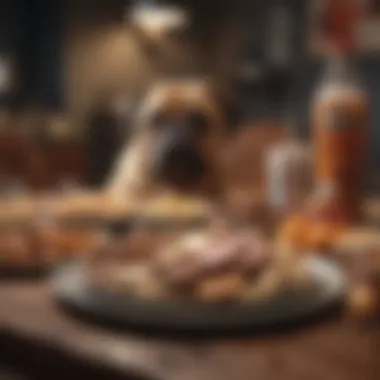Essential Foods to Avoid for Your Dog's Safety and Health


Intro
Understanding what foods can harm dogs is essential for every pet owner. The dietary choices we make for our canine companions can determine their overall health and longevity. It's imperative to know which items to avoid for their safety. Below, we outline specific foods that should never be part of a dog's diet. This knowledge aids in preventing accidental ingestion and promotes better canine nutrition.
Animal Overview
Common Names
When discussing dogs, we primarily refer to them by their common name, dogs, though they might also be known as domestic dogs in some contexts. The domesticated dog has been a companion to humans for thousands of years, weaving into our social fabric.
Scientific Classification
The scientific classification of dogs is straightforward. They belong to the species Canis lupus familiaris, which is part of the family Canidae. This classification marks the dog as a subspecies of the gray wolf, highlighting their shared ancestry.
Geographic Range
Domesticated dogs are found nearly everywhere on the planet. They thrive in various environments, from urban areas to rural landscapes. Their adaptability to various climates and conditions allows them to coexist with humans across diverse geographic regions.
Common Harmful Foods
To ensure the health and safety of dogs, owners should be aware of several specific foods that can pose risks:
- Chocolate: Theobromine in chocolate is toxic to dogs.
- Onions: Contains compounds that damage red blood cells.
- Garlic: Can lead to gastrointestinal upset and toxicity.
- Grapes and Raisins: Can cause kidney failure.
- Xylitol: A sugar substitute that can lead to insulin release and liver failure.
It is important to note that even in small amounts, the consumption of these foods can lead to severe health issues in dogs.
Physiological Effects
The ingestion of harmful foods can lead to a range of physiological problems for dogs. Symptoms may include:
- Vomiting
- Diarrhea
- Lethargy
- Abdominal pain
- Seizures
In severe cases, ingestion can be fatal. Early intervention is key, often necessitating veterinary assistance.
Prevention and Education
Educating oneself about canine safety not only protects pets but also fosters a stronger bond between the dog and owner. By curating a safe and healthy diet, dog owners contribute significantly to their pet's overall well-being. Understanding what to avoid allows for more informed choices, reducing the risk of accidental ingestion.
The End
Being proactive in your dog’s nutrition is a crucial part of responsible pet ownership. This guide aims to enlighten dog owners about dangerous food items, thus enhancing their ability to provide a safe environment. The health and happiness of our dogs rely on informed dietary decisions.
Understanding Dog Nutrition
Dog nutrition forms the cornerstone of a dog’s health and well-being. An in-depth understanding of their dietary needs helps pet owners make informed decisions that affect both short-term and long-term health outcomes. Dogs, while often considered carnivorous by nature, are actually omnivores. Therefore, their diet can be composed of a variety of food sources.
Recognizing the significance of a balanced diet is not only about preventing harmful foods but also ensuring proper nutrition. A balanced diet includes proteins, fats, carbohydrates, vitamins, and minerals tailored to a dog's specific life stage and health condition. Each nutrient plays a vital role in bodily functions such as growth, energy, and organ health.
Avoiding harmful foods often starts with understanding the basic principles of dog nutrition. You have to consider not only what dogs can eat, but also what they cannot. For instance, many pet owners remain unaware of the toxicity of certain human foods like chocolate, grapes, and onions. Knowledge of these dangers effectively helps in creating a safer environment for their furry friends.
The Importance of a Balanced Diet
Maintaining a balanced diet for dogs is critical. A lack of essential nutrients can lead to a variety of health issues. For instance, insufficient protein can result in muscle wastage and a poor coat. Similarly, a deficit in fiber can lead to digestive problems. To sum up, balancing macronutrients like proteins, fats, and carbohydrates—as well as micronutrients—is vital. It directly influences their energy levels, behavior, and overall health.
The ideal dog diet usually includes high-quality commercial dog food that meets the standards set by veterinary nutritionists. Supplementing this diet occasionally with safe fruits and vegetables can enrich your dog’s meals. Some examples include carrots, green beans, and blueberries.


Key Takeaways:
- Essential nutrients directly affect your dog’s health.
- Balanced diets help prevent health problems.
- Quality dog food meets nutritional standards.
- Safe fruits and veggies can enhance meals.
Common Misconceptions About Dog Food
The realm of dog nutrition is filled with misconceptions that can lead to poor feeding practices. A common myth is that dogs thrive solely on meat. While protein is essential, some carbohydrates, especially those from whole grains, are crucial for sustained energy and digestive health.
Another misconception is that it is safe to feed dogs table scraps. Many of the foods we consume can be harmful to dogs. They are often rich in fats, salts, and spices that are not suitable for canine health. Misunderstanding what constitutes a healthy treat can lead to accidental poisoning or chronic health issues.
Furthermore, many believe that all commercial dog food is equal. In reality, quality varies tremendously. It is essential to read labels and choose products that specify real meat as the primary ingredient rather than vague terms like “meat by-products.”
It’s critical to educate oneself about dog nutrition, as misconceptions can have dire consequences for health.
Foods That Should Never Be Fed to Dogs
The health and safety of dogs is paramount for any responsible pet owner. While many foods are safe for consumption by dogs, there are several items that can be downright harmful. It is crucial to identify these foods to prevent potential health risks. This section will provide insight into specific items that should never be included in a dog's diet. Being informed can protect dogs from accidental poisoning and can promote a healthier lifestyle overall.
Chocolate
How Theobromine Affects Dogs
Theobromine is a compound found in chocolate that is particularly toxic to dogs. Unlike humans, dogs metabolize theobromine at a much slower rate. This slow breakdown can lead to a buildup of potentially lethal levels in a dog's system. Theobromine affects the central nervous system and cardiovascular function. Even small quantities can cause serious health issues. Therefore, dog owners must be vigilant in keeping chocolate out of reach. Understanding the risks associated with theobromine is vital for ensuring canine safety.
Signs of Chocolate Toxicity
Recognizing the signs of chocolate toxicity is essential for timely intervention. Common symptoms include vomiting, diarrhea, rapid breathing, increased heart rate, and restlessness. In severe cases, seizures and even death can occur. If a dog displays any of these symptoms after ingesting chocolate, immediate veterinary care is necessary. Awareness of these warning signs can help guardians act quickly, potentially saving the dog's life.
Onions and Garlic
Impact on Red Blood Cells
Onions and garlic contain compounds that can harm a dog’s red blood cells. These substances can lead to hemolytic anemia, a condition where red blood cells are destroyed faster than they can be made. This risk is heightened especially in breeds like the Shiba Inu and Akita. It is crucial for owners to understand this impact, particularly when considering foods that contain these ingredients. Avoiding onions and garlic in any form is necessary for a dog’s long-term health.
Symptoms of Poisoning
The symptoms associated with onion and garlic poisoning may take time to appear. They can include lethargy, weakness, decreased appetite, and pale gums. If any of these symptoms arise after potential exposure, contacting a veterinarian is essential. Timely treatment can prevent further health deterioration. Understanding the signs can promote quicker response actions by pet owners.
Grapes and Raisins
Potential for Acute Kidney Failure
Both grapes and raisins can cause unexpected acute kidney failure in dogs. The exact substance within these fruits that contributes to toxicity is not yet identified. Even a small amount can lead to severe renal issues. The danger lies in the fact that some dogs may not exhibit immediate symptoms, making caution even more critical. Dog owners should guard against offering any form of grape or raisin.
Recognizing Early Signs of Reaction
Early intervention is crucial when a dog consumes grapes or raisins. Signs of a reaction may include vomiting, lethargy, and loss of appetite. These symptoms can escalate rapidly, leading to devastating outcomes if not addressed promptly. Dog owners must remain vigilant in recognizing these signs within hours of ingestion, ensuring a chance for effective treatment.
Avocado
Persin and Its Toxicity
Avocado contains a substance called persin, which can be toxic to dogs. While the level of toxicity varies depending on the avocado type, it generally poses health risks including gastrointestinal upset and pancreatitis. Dog owners must recognize that even small amounts thereof can be harmful. Awareness around persin's presence and its repercussions is necessary to maintain a dog's health.
Effects on Dogs' Digestive Systems


Consumption of avocado can lead to upset stomach and vomiting in dogs. These digestive systems disturbances can be distressing for both the dog and owner. Dogs may have varying tolerance levels, but caution is advisable. Understanding these effects can help guardians make informed decisions about their pet's diet.
Macadamia Nuts
Symptoms of Toxicity in Dogs
Macadamia nuts are another significant risk for dogs. Symptoms of toxicity can manifest within hours of ingestion. Affected dogs may show signs such as weakness, vomiting, and tremors. The severe symptoms can last from 24 to 48 hours, causing undue stress for owners. It is critical to avoid feeding dogs any form of macadamia nuts.
Long-term Health Effects
Repeated exposure to macadamia nuts can cause long-lasting health issues. Regular consumption can lead to nerve damage and decreased muscle control. Understanding these long-term effects can reinforce the necessity of avoiding this snack, protecting a dog’s health in the long run.
Caffeine
Stimulant Effects on Dogs
Caffeine is a potent stimulant that significantly affects dogs. It can lead to hyperactivity and can increase heart rate, potentially causing severe cardiovascular problems. Just a small amount can result in serious complications. Keeping caffeine-containing products away from dogs is vital for their safety. Knowledge of these stimulant effects can aid dog owners in avoiding such negligence.
Health Risks and Symptoms
Signs of caffeine consumption may include restlessness, rapid breathing, and heart palpitations. In severe cases, it can be fatal. Understanding these health risks illustrates how crucial it is to monitor what dogs may access within the household. Quick action can prevent severe outcomes.
Xylitol
How Xylitol Affects Insulin Levels
Xylitol is often used as a sugar substitute in many products, but it can cause a rapid release of insulin in dogs. This spike leads to hypoglycemia, which can be life-threatening. Even small amounts can be dangerous. Dog owners must be aware that xylitol is often found in common items like gum and candies, driving the need for vigilance in product choices.
Signs of Xylitol Poisoning
The symptoms of xylitol poisoning can develop swiftly. Early signs may include vomiting, loss of coordination, and seizures. Timely recognition is critical, as rapid treatment can change the outcome for the affected dog. Understanding potential xylitol sources reinforces the importance of safeguarding against accidental exposure.
Alcohol
Impact on Dog Physiology
Alcohol affects dogs significantly more than humans. Even a small amount can lead to intoxication, resulting in a variety of health issues. Symptoms may range from vomiting and disorientation to respiratory distress. The danger is evident; therefore, alcohol should never be given to dogs. Education on this impact can inform owners about the risks associated with alcohol ingestion.
Health Risks Associated with Ingestion
The health risks associated with alcohol ingestion are severe. Dogs can experience organ failure, and in extreme cases, death. This makes it imperative for pet owners to understand the high stakes involved. Knowledge helps ensure that dogs remain safe and healthy.
Certain Dairy Products
Lactose Intolerance in Dogs
Many dogs are lactose intolerant, meaning they cannot properly digest dairy products. This intolerance can lead to gastrointestinal distress, including diarrhea and flatulence. While some dogs may tolerate small amounts, caution is essential. Being aware of lactose intolerance helps owners make better dietary choices for their pets.
Symptoms of Digestive Distress
Symptoms of distress after ingestion may include bloating, gas, and diarrhea. Recognizing these symptoms can aid quick interventions if dairy is consumed. Understanding these digestive impacts emphasizes the need for careful monitoring of a dog’s diet.
Stone Fruits
Potential for Intestinal Blockage


Stone fruits like peaches and cherries have pits that pose a choking hazard for dogs. If swallowed, these pits can lead to intestinal blockage, which can be a life-threatening condition. Dog owners should remain cautious and never allow their pets access to these fruits. Being aware of the risks associated with these fruits is critical for responsible pet ownership.
Chemical Compounds in Pits
Additionally, the pits of some stone fruits contain cyanogenic compounds. These substances can produce cyanide in the body, posing further hazards. Understanding these risks can significantly contribute to preventing unintentional exposure, ensuring that dogs lead healthy lives.
Effects of Harmful Foods on Dog Health
Understanding the effects harmful foods have on a dog's health is vital for any pet owner. This knowledge can significantly impact the overall well-being of dogs. Unsafe foods often lead to immediate reactions, which can be alarming and require urgent care. In addition, many harmful ingredients can result in long-term health issues that not only affect the quality of life of the pet but also place a burden on the owner's emotional and financial resources. Hence, highlighting these issues equips dog owners with the necessary information to make informed dietary choices.
Immediate Reactions and Symptoms
When dogs consume harmful foods, the body reacts in various ways. Immediate symptoms can occur within a few hours or even minutes. Common signs of a negative reaction may include:
- Vomiting and Diarrhea: These are often the first symptoms that arise, signaling the body’s attempt to eliminate toxins.
- Abdominal Pain: Dogs may exhibit discomfort, often by whining, pacing, or adopting unusual positions.
- Lethargy: If a dog appears unusually tired after consuming harmful food, it may indicate a serious issue.
- Increased Heart Rate: This can occur particularly after ingesting stimulants like caffeine.
It is crucial for dog owners to observe any changes in their pet's behavior after food ingestion. Quick identification of symptoms can lead to prompt veterinary intervention, which may mitigate more severe health impacts.
Remember, understanding these immediate reactions potentially saves a dog's life.
Long-term Health Consequences
Beyond immediate symptoms, the long-term effects of feeding harmful foods to dogs can be quite grave. Certain items may lead to chronic health conditions over time. Here are some potential long-term consequences:
- Kidney Damage: Foods like grapes and raisins can cause severe kidney issues, possibly resulting in chronic conditions or failure.
- Anemia: Ingredients like onions and garlic can impair red blood cell function, leading to ongoing health problems linked to anemia.
- Neurological Issues: Consumption of substances such as chocolate or caffeine can result in lasting neurological impairment, affecting motor skills and behavior.
- Digestive Disturbances: Regular ingestion of harmful substances can lead to digestive disorders, making future food consumption difficult and painful for dogs.
Keeping a vigilant eye on what your dog eats and understanding the long-term impacts fosters responsible pet ownership. Knowledge in these areas allows for proactive measures that protect dogs from preventable health issues and enhances their overall well-being.
Preventative Measures for Dog Owners
It is vital for dog owners to understand preventative measures that ensure the safety and health of their pets. Awareness and proactive approaches can make a significant difference in avoiding accidental ingestion of harmful foods. Such measures include creating a secure food environment and educating those around you about what is safe for dogs. By taking these steps, owners can protect their dogs from various health risks associated with inappropriate dietary choices.
Creating a Safe Food Environment
Creating a safe food environment is necessary for every dog owner. One of the first steps is to establish specific areas in the home where food for humans is stored, keeping it out of reach of the dog. Securing cabinets and pantries with childproof locks can help prevent curious pups from accessing harmful items. Additionally, having designated places for dog food can minimize confusion.
Here are some practical strategies to ensure safety:
- Keep hazardous food items out of reach: Placing items like chocolate, grapes, and onions on high shelves or within locked cabinets is essential.
- Use pet-proof containers: Storing human food in airtight, pet-proof containers can prevent accidental spills and access.
- Monitor food preparation areas: Always supervise your dog while cooking, as leftovers can easily tempt them or lead to a harmful situation.
- Dispose of waste properly: Ensure that garbage cans have secure lids and are not accessible. Many dogs will rummage through trash, finding potentially dangerous items.
Implementing these measures can significantly reduce the risk of exposure to dangerous foods.
Educating Family and Friends
Education is crucial in maintaining your dog's safety. It is important that not only dog owners, but also family and friends understand what foods are harmful. Many accidents occur due to unknowing guests feeding a pet without considering the risks. Engaging everyone who interacts with your dog can help prevent accidents and promote a culture of safety.
Consider the following approaches:
- Communicate dietary restrictions: Make a clear list of foods to avoid and share it with visitors. This can be posted on the refrigerator for quick reference.
- Host informative sessions: Hold discussions with family and friends to explain why certain foods are hazardous. Understanding the reasons can persuade adherence to dietary rules.
- Model safe behavior: When offering treats or food, demonstrate appropriate choices. This can show others that your dog's health is a priority.
- Engage online communities: Platforms like reddit.com can provide valuable insight and discussions about dog nutrition and safety. Engaging with online forums can help broaden knowledge.
Educating those around you fosters a supportive environment for your dog's well-being.
By prioritizing safety and education, dog owners can significantly minimize the risk of harmful foods affecting their pets' health.
The End
The effects of harmful foods can be immediate and severe. Recognizing symptoms quickly can save a dog's life. Thus, early education and awareness can prevent unfortunate incidents.
Furthermore, fostering a safe food environment at home can greatly minimize the risks. Properly storing food items out of reach and educating family members can aid in preventing accidental ingestion.
By prioritizing informed dietary choices, pet owners can not only safeguard their dogs against harmful foods but also promote overall health. A balanced diet is essential for a dog's well-being; hence, understanding what to avoid is equally as important as knowing what to feed them.







